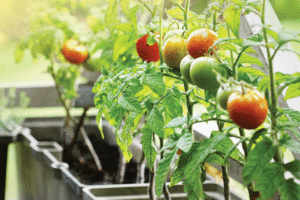
Beyond their showy variety names, tomatoes don’t play back row in the garden. They want the full sun spotlight right on them, and prefer a new spot every year.
Whether you are trying to take a long, ruffly blue ribbon or simply trying to have an out-of-this-world BLT, there are tomatoes … and then there are champion tomatoes.
Champion Tomatoes are the ones that are perfectly red, perfectly round, with the taste you think about all winter long.
Whether it’s a friendly race between neighbors or a judged show, getting that first ripe tomato as soon as possible is many a gardener’s goal.
Competitive tomato growing dates back to when word of mouth had to spread the word of whose garden tomatoes were the juiciest around and the prize was simply a smug knowingness.
If you were to have an off year in your garden, you could bet there would be whispers, as if you had run off to join the circus.
These days, county and state fairs and festivals fuel the competition to an extent that several seed companies have taken notice started marketing toward the crowd with varieties alluding to earlier ripeness like “Fourth of July” or “Early Girl” as well as championship tendencies such as ”Early Blue Ribbon” or, simply put “Wins All.”
These varieties have shorter growing periods that hint at a taste of victory.
That said, experienced tomato contestants likely wouldn’t ditch their tried and true varieties, not only because of the risk but also because “their” variety has likely been their family variety for a few generations.
Popular in contests are “Celebrity,” a sandwich size variety that checks all the boxes in shape, color and taste, as well as “Beefsteak,” “Big Beef” and “Delicious,” which can be monstrous ranging from a pound or two.
Beyond their showy variety names, tomatoes don’t play back row in the garden either — they want the full sun spotlight right on them, and prefer a new spot every year.
They like warm, loose soil, don’t like their feet wet, but prefer it to be constantly damp instead.
The most serious control-freak tomato growers start their own seeds, hoping to avoid early disease issues from someone else’s transplants and apply water at the roots, rather than overhead.
Tomato cages or a staked trellis are at least 6 feet tall to support the plants.
When tomatoes reach ping pong ball size, fertilization starts with a few tablespoons every three weeks or so.
It’s a finely tuned dance that growers take on year after year.
Now late in the season, if you’re still itching to plant, don’t be tempted to get a transplant with too many tomato starts on it — that could be a sign that it was overfertilized and may not be able to finish and ripen all the tomatoes it has started.
As showtime approaches, many tomato contestants swear by putting all focus into one tomato — they will pick the best fruit on each plant and strip the others so the plant’s focus is only on the tomato chosen.
Then they worry for weeks their tomato won’t ripen before the contest begins, leaving them with nothing to bring to the table.
Obviously hard work won’t go unpunished.
Between the tomato hornworm to handpick off, multiple fungi-induced wilt issues, beetle infestations tomatoes have lots of pests attracted to them that keep champion hopefuls with their guards up as well.
Fruit with black bottoms, known as Blossom End Rot, or splits on the stem side both lead back to inconsistent watering, such as a drought followed by heavy rain, or you going on a beach vacation and leaving your plants unattended.
While the pros keep a log with amounts of rain and manual watering, at least devise a loose schedule for watering.
When it comes to competition time, contestants are out for blood — red color.
Though an ugly tomato may taste the same, judges are looking for uniform size, shape, color and firmness for cutting.
Sometimes, the judges will not even cut or taste the tomatoes — it’s looks alone.
Conversely, in a size competition green and ugly will do just fine.
The largest tomato currently on record, from Dan MacCoy out in Minnesota, weighed in at 8.41 pounds, with a disfigured shape and multiple shades of green and pale reds.
No matter your end goal, it’s likely if you have a garden, you have tomatoes and high hopes for your crop.
Like children, tomatoes will keep you busy during the day, taking care of them and up at night wondering if they are growing strong.
But at least at the end of the journey, you can eat tomatoes on a sandwich!




